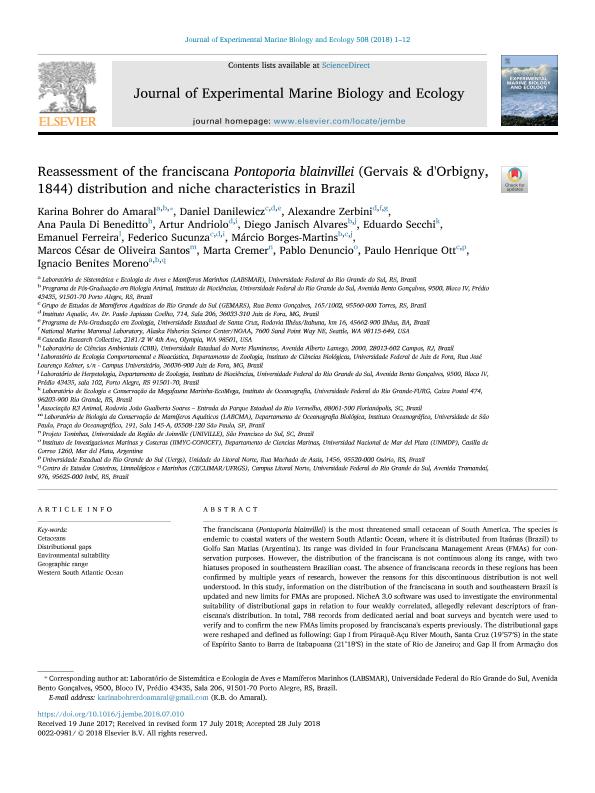Artículo
Reassessment of the franciscana Pontoporia blainvillei (Gervais & d'Orbigny, 1844) distribution and niche characteristics in Brazil
do Amaral, Karina Bohrer; Danilewicz, Daniel; Zerbini, Alexandre; Di Beneditto, Ana Paula; Andriolo, Artur; Alvares, Diego Janisch; Secchi, Eduardo Resende; Ferreira, Emanuel; Sucunza, Federico; Borges Martins, Márcio; de Oliveira Santos, Marcos César; Cremer, Marta; Denuncio, Pablo Ezequiel ; Ott, Paulo Henrique; Moreno, Ignacio Benites
; Ott, Paulo Henrique; Moreno, Ignacio Benites
 ; Ott, Paulo Henrique; Moreno, Ignacio Benites
; Ott, Paulo Henrique; Moreno, Ignacio Benites
Fecha de publicación:
22/08/2018
Editorial:
Elsevier Science
Revista:
Journal of Experimental Marine Biology and Ecology
ISSN:
0022-0981
e-ISSN:
1879-1697
Idioma:
Inglés
Tipo de recurso:
Artículo publicado
Clasificación temática:
Resumen
The franciscana (Pontoporia blainvillei) is the most threatened small cetacean of South America. The species is endemic to coastal waters of the western South Atlantic Ocean, where it is distributed from Itaúnas (Brazil) to Golfo San Matias (Argentina). Its range was divided in four Franciscana Management Areas (FMAs) for conservation purposes. However, the distribution of the franciscana is not continuous along its range, with two hiatuses proposed in southeastern Brazilian coast. The absence of franciscana records in these regions has been confirmed by multiple years of research, however the reasons for this discontinuous distribution is not well understood. In this study, information on the distribution of the franciscana in south and southeastern Brazil is updated and new limits for FMAs are proposed. NicheA 3.0 software was used to investigate the environmental suitability of distributional gaps in relation to four weakly correlated, allegedly relevant descriptors of franciscana´s distribution. In total, 788 records from dedicated aerial and boat surveys and bycatch were used to verify and to confirm the new FMAs limits proposed by franciscana´s experts previously. The distributional gaps were reshaped and defined as following: Gap I from Piraquê-Açu River Mouth, Santa Cruz (19°57′S) in the state of Espírito Santo to Barra de Itabapoana (21°18′S) in the state of Rio de Janeiro; and Gap II from Armação dos Búzios (22°44′S) to Piraquara de Dentro (22°59′S) in Rio de Janeiro. The ecological niche model indicated that distributional gaps are inside franciscana´s fundamental niche, and are relatively suitable in terms of salinity, temperature, diffuse attenuation and bathymetry. However, the narrow of continental shelf seems to be the main factor explaining the absence of franciscanas in the distributional gaps as well as for the differentiation of some of the FMAs proposed. Narrowness of continental shelf seems to be intensifying the dynamics of biotic interactions promoting food competition for example, and/or causing geographic limitation to maintain minimal viable population size in present or past times periods.
Palabras clave:
Cetaceans
,
Distributional gaps
,
Environmental suitability
,
Geographic range
Archivos asociados
Licencia
Identificadores
Colecciones
Articulos(IIMYC)
Articulos de INSTITUTO DE INVESTIGACIONES MARINAS Y COSTERAS
Articulos de INSTITUTO DE INVESTIGACIONES MARINAS Y COSTERAS
Citación
do Amaral, Karina Bohrer; Danilewicz, Daniel; Zerbini, Alexandre; Di Beneditto, Ana Paula; Andriolo, Artur; et al.; Reassessment of the franciscana Pontoporia blainvillei (Gervais & d'Orbigny, 1844) distribution and niche characteristics in Brazil; Elsevier Science; Journal of Experimental Marine Biology and Ecology; 508; 22-8-2018; 1-12
Compartir
Altmétricas



